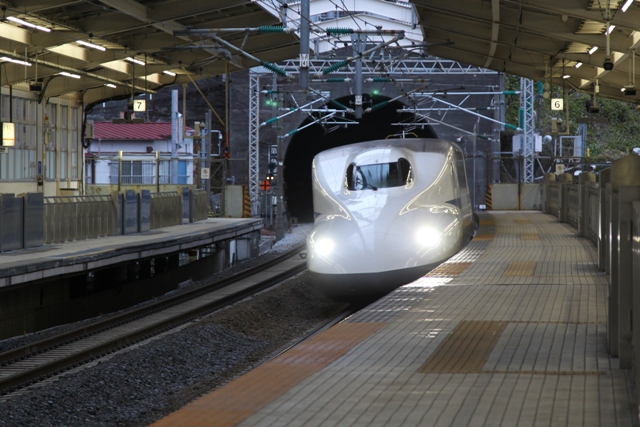
Shinkansen N700 series at Tokyo Station
As I introduced before (see the blog of April 23rd, 2011), “Shinkansen” is the train that represents Japan. Its total railway network length is nearly 2400km and there are 1 million passengers per day now.
The history of the Shinkansen started in 1964 when the Tokaido Shinkansen was opened between Tokyo and Shin-Osaka stations. The round-nosed first Shinkansen train; EMU 0 series was launched just before the Tokyo Olympics. So far in the 47 years, Japan National Railway and its successors; JR companies have launched 15 series of trains one after another.
Look at the top photo. It’s the EMU JR Central and West N700 series at Tokyo Station. This train, which was launched in 2005, is the latest model on the Tokaido and the Sanyo Shinkansen. It consists of 16 cars (2 units of 3M1T and 2units of 4M) and its maximum speed is 300km/h on the Sanyo Shinkansen, meanwhile 270km/h on the Tokaido Shinkansen.
The most distinctive feature of N700 series is its improvement in speed on a curve passage. There are a lot of tight curves on the Tokaido Shinkansen because it's the oldest one. Its minimum curve radius is 2500m; therefore, the maximum speed on a curve passage was limited to only 255km/h in the past. However, by tilting the train's body with a high technology, the N700 series achieved operating at a speed of 270km/h on a 2500m radius curve passage.
JR N700 series … it’s a culmination of Shinkansen technologies.
The history of the Shinkansen started in 1964 when the Tokaido Shinkansen was opened between Tokyo and Shin-Osaka stations. The round-nosed first Shinkansen train; EMU 0 series was launched just before the Tokyo Olympics. So far in the 47 years, Japan National Railway and its successors; JR companies have launched 15 series of trains one after another.
Look at the top photo. It’s the EMU JR Central and West N700 series at Tokyo Station. This train, which was launched in 2005, is the latest model on the Tokaido and the Sanyo Shinkansen. It consists of 16 cars (2 units of 3M1T and 2units of 4M) and its maximum speed is 300km/h on the Sanyo Shinkansen, meanwhile 270km/h on the Tokaido Shinkansen.
The most distinctive feature of N700 series is its improvement in speed on a curve passage. There are a lot of tight curves on the Tokaido Shinkansen because it's the oldest one. Its minimum curve radius is 2500m; therefore, the maximum speed on a curve passage was limited to only 255km/h in the past. However, by tilting the train's body with a high technology, the N700 series achieved operating at a speed of 270km/h on a 2500m radius curve passage.
JR N700 series … it’s a culmination of Shinkansen technologies.
